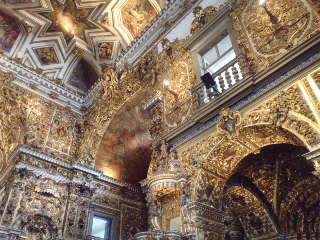When it comes to Salvador,
think Africa in South America, but with a Portuguese flavor. Salvador was Brazil’s main seaport during the
active Brazilian slave trading era (16th and 17th centuries). After the slaves were freed, Salvador became
home to a unique African population located in South America. Everywhere you look you see the influence of
African culture. 80% of the population
of Salvador are direct descendants of African slaves making for a very unexpected
visitor experience.
When all is said and done,
Salvador is more of a shopping port than anything else. In fact, there is so much diversity in the
different products that are available that it is astonishing. We stopped in a store and Terry took my photo
next to a lady in traditional dress. I
thanked her by saying Obrigado, “thank you” in Portuguese, and the only
Portuguese word I can remember. She just
beamed and appreciated my effort.
The first thing one notices is
the number of churches that reside in the historic Pelourinho district of
Salvador. There seems to be a church on
every corner. They say there are over 165 at last count! We had the opportunity
to go into the Church and Convent of Saint Francis. We see beautiful blue tile mosaics lining the
cloister. The tiles came from Portugal
between 1743 and 1746. This is the
largest collection of blue tiles outside of Portugal.
The Church of St. Francis is
one of the best models of the first age of the Baroque style, or as it is
usually called “the colonial style”. The
carvings are completely covered with gold leaf and gives the impression of a
Golden Church. Stepping into the church
was jaw dropping!
 |
| Outside of St. Francis Church |
The city of Salvador is divided
into two levels. There is the Lacerda
Elevator, which takes one from the lower to upper level on top of a hill. It costs R$.50 in Brazilian money (Reals),
which is about US$.30 for a ride. The
views from the top overlooking the ocean are wonderful.
 |
| Elevator from the lower part of city to the top of the hill |
Walking through the Pelourinho
district is a living reminder of its Portuguese colonial past. The cobbled streets are lined with colorful
churches, museums, boutiques, and houses.
This is the area of town that holds the Carnaval celebrations and
parades. The Salvador Carnaval is by far
the biggest street party in the world.
Every year around 2 million people participate in the parades. During six consecutive days, from 5 pm to 5
am, dozens of bands make a parade along the streets, playing on big trucks
(called Trios). We won’t see this as the
ship leaves port at 5 pm.
 |
| Welcome to Salvador Carnaval |
 |
| Crowds, but nothing like the evening crowds. These are all tourists. |
 |
| African drums, etc. for sale |
 |
| Hair all decked out for a party |
 |
| Carnaval ribbons adorn the fences |
 |
| Art for sale |
 |
| This guy had the coolest job in town. That's ice he's carrying on his head. |
 |
| Coconut water for sale |
 |
| Lots and lots of jewelry for sale |
But after a day at sea, the
next stop is Rio deJaniero and we will be at port overnight and plans are to
get over to the Sambradome where Carnaval takes place. We will tour Rio during the day on Sunday,
hope to see a little bit of Carnaval at night, and then the next day we leave
the ship and fly to Iguazu Falls for 3 nights.
We will return to the ship on February 14 when it arrives in Buenos
Aires. I won’t be taking the laptop with
so this will probably be the last posting for about at least a week.
Today was an excellent day; we
had a lot of fun exploring Salvador. The
temperature was forecasted for 84 degrees.
With almost 100% humidity and sun, that was the hottest 84 degree day we
have ever experienced. Back on the ship,
we sailed away from Salvador and enjoyed cooling off in the pool.

















Love your pictures. Stay healthy, we got sick on our trip and are still not feeling well. Anxious to read about your trip to the falls.
ReplyDelete